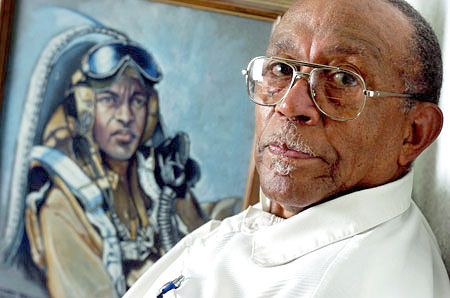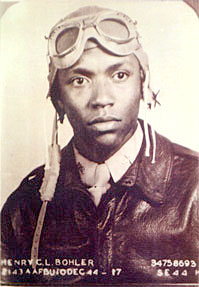Always a flier at heart
By COLETTE BANCROFT
Published July 26, 2005
 [Times photo: Daniel Wallace] Henry Bohler, 80, a member of the Tuskegee Airmen during World War II, plans to attend the national convention this fall in Orlando. The painting to his left is a rendition of a photo taken of him while he was in the service. |
 [Photo courtesy of Henry Bohler This is a photo of Henry Bohler when he was a 17-year-old member of the Tuskegee Airmen. Their achievements were key in the integration of the American military. |
TAMPA – At 80, Henry Bohler still maintains his military bearing: spine straight, shoulders squared. And he is still passionate about what he learned as a Tuskegee Airman: “I love to fly.”
In the 1940s, commercial aviation was in its infancy, and few Americans, black or white, had ever taken to the air. The U.S. military, still segregated, had no black pilots when it entered World War II.
But Bohler was fascinated by flying from the time he was a child in Augusta, Ga. “When I graduated from high school, I wanted to fly,” he says.
After completing his first year at Hampton University in Virginia, he read about the Tuskegee Airmen and saw his opportunity.
“I took the exam, and I was admitted,” he says, and was off to training at Keesler Field in Biloxi, Miss., at age 17.
From there he went to Tuskegee, Ala., for primary flight training. “That was when I got my first look at a plane up close.”
The cadets started out in a Stearman PT-17, a two-seater biplane. The student sat in the front cockpit, the instructor in the second cockpit with his own set of controls.
Bohler soloed three months after his first look at a plane. “It felt okay,” he says with a grin.
He completed his training in December of 1944. About half of the Tuskegee Airmen were posted to the European Theater of the war, and that’s where Bohler wanted to be: “I wanted to shoot down (Germans).”
But he stayed stateside, stationed at Walterboro Army Air Field in South Carolina and then at Goodman Army Air Field in Kentucky. “We flew missions just like we were overseas.”
Although there were plans in 1945 to send the 477th Group, the composite bombardment and fighter group of Tuskegee Airmen based at Goodman, to combat in the Pacific, the war ended before they could be deployed.
Bohler knows exactly how long he was a Tuskegee Airman: “Three years, six months and 16 days.”
He left the Army Air Forces at 20, as a second lieutenant, and returned to Hampton to complete his degree in vocational education. After teaching for a couple of years, he moved to Tampa in 1950.
He decided to become an electrical contractor, passing the exam with the highest score at that time, he says, and had his own business for more than 30 years before he retired.
“We lived in the projects for 10 years, then I built this house myself,” he says of the trim yellow brick house in Belmont Heights he shares with his wife, Clifford Marie, a registered nurse. They have been married for 56 years and have three children – George, Henry and Pamela – eight grandchildren and two great-grandchildren.
But no matter how busy his family and business kept him, Bohler never stopped flying.
After the war, he wanted to be a commercial pilot and got his commercial license, but airlines in the United States were not hiring black pilots despite the Tuskegee Airmen’s sterling record in the war.
“Some of them went down to South America and worked as commercial pilots, but I was bent on staying here.”
He bought his first plane 30 years ago. He has owned three: a Piper Apache, a Piper Cherokee and now a Commander. “I have flown all over the country,” he says.
Bohler was one of the founders of Ye Mystic AirKrewe, which does flyovers of the Gasparilla Pirate Invasion and other events.
He was piloting his plane up until this year, when a stroke left his speech slowed. “I can’t talk to the towers, so I lost my license.”
But he still goes up with friends who are pilots, and he still enjoys the Tuskegee Airmen conventions. The 34th annual meeting is in August in Orlando. “I’ve been going since day one, to Seattle, Los Angeles, Denver,” Bohler says. “We are all friends.”
The best part of the conventions, he says, is “looking at new planes.”
Besides fulfilling his dream of flying, Bohler says, being a Tuskegee Airman also left him with a desire to pass along the group’s history and ideals to the community.
The walls of his family room are covered with plaques and awards from schools, organizations and government bodies commending him for his service.
He has often spoken to children about his experience as a Tuskegee Airman, and he says they always ask the same questions: “They just want to know about flying.”
– Colette Bancroft can be reached at 727 893-8435 or bancroft@sptimes.com
 Our World War II Veterans
Our World War II Veterans